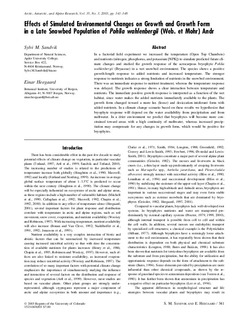Effects of simulated environmental changes on growth and growth form in a late snowbed population of pohlia wahlenbergii (Web. et Mohr) Andr
Original version
Arctic, antarctic and alpine research 35 (3): 341-348. Copyright, Regents of the University of ColoradoAbstract
In a factorial field experiment we increased the temperature (OpenTop Chambers) and nutrients (nitrogen, phosphorus, and potassium[NPK]) to simulate predicted future climate changes and studiedthe growth response of the acrocarpous bryophyte Pohliawahlenbergii (Bryaceae) in a wet snowbed environment. The speciesshows a positive growth-length response to added nutrients andincreased temperature. The stronger response to nutrientsindicates a strong limitation of nutrients in the snowbedenvironment. There was an immediate response to nutrienttreatment, whereas the temperature response was delayed. Thegrowth response shows a clear interaction between temperature andnutrients. The immediate positive growth response is interpretedas a function of the wet habitat, since water makes the addednutrients immediately available to the plants. The growth formchanged toward a more lax (loose) and desiccation-intolerant formwith added nutrients. In a climate change scenario based on theseresults we hypothesize that bryophyte response will depend on thewater availability from precipitation and from meltwater. In adrier environment we predict that bryophytes will become moreconstrained toward areas with a high continuity of meltwater,whereas increased precipitation may compensate for any changes ingrowth form, which would be positive for bryophytes.
